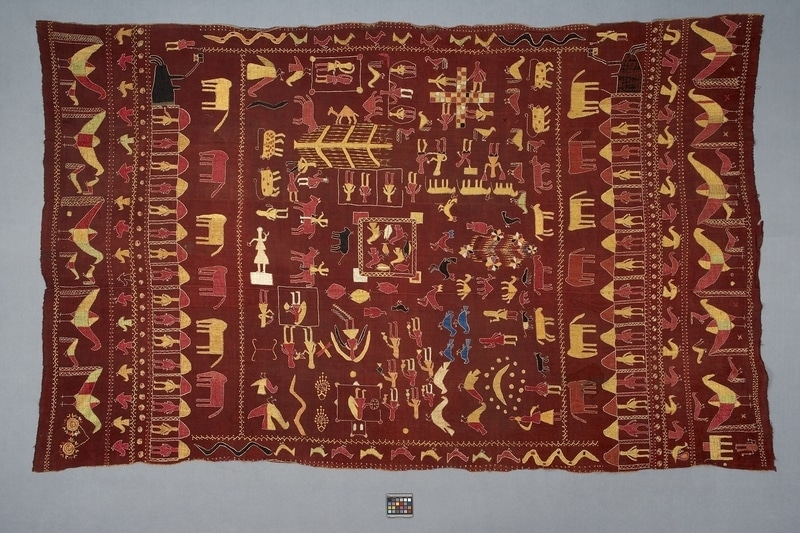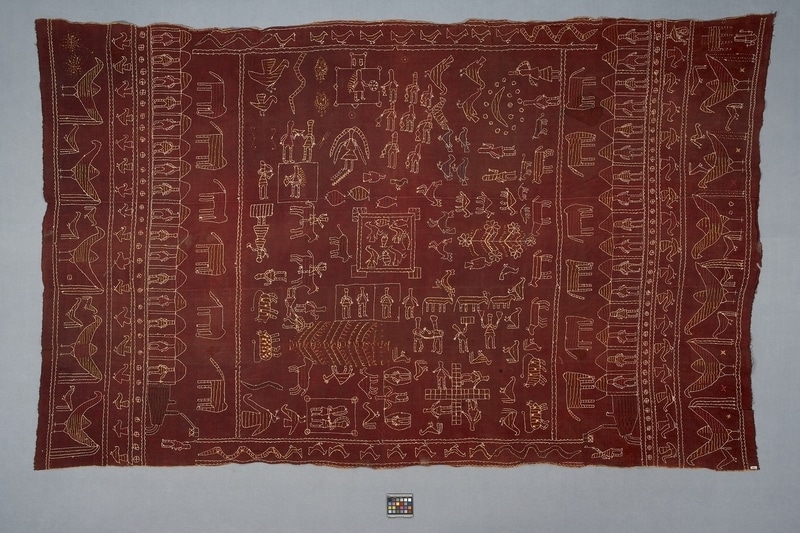Textile Item Number: Ef408 from the MOA: University of British Columbia


Description
A long rectangular cotton cloth (khaddar) of three hand sewn long panels with the sides unfinished along the top and bottom. Side edging in blanket stitch; embroidered with silk threads. Central motif has people carrying lanterns, games, food preparation, dancers and head jewelry. Motifs at each end are almost mirror images. From edge: large with small birds, seventeen small birds, small circles, people in a train, engine and cupolas, and six elephants. Side borders have snakes and birds.
History Of Use
Once an important part of bride's trousseau. Also used for bedspreads, curtains, dresses, bags, and cushions.
Iconographic Meaning
One motif on this phulkari depicts a story from the Mahabharata: a man carried his blind parents everywhere on a shoulder yoke. He was killed by King Dasaratha who mistook the man for a deer while hunting. The parents cursed the king that the king's son, Rama, would die young. Slight imperfections in the patterns are placed throughout the cloth to ward off evil (nazar butti); for example one peacock has a red line on its neck, the bottom right peacock is more elaborate than others and one peacock is not filled in. Deliberate imperfections are a way for the makers to demonstrate that their works are not perfect, and hence divine.
Item History
- Made in Punjab, India during 1900
- Owned by Sotheby Parke Bernet Ltd. before August 22, 1979
- Received from Sotheby Parke Bernet Ltd. (Seller) and Fyfe-Smith Memorial Oriental Collection Fund (Funding source) on August 22, 1979
What
- Name
- Textile
- Identification Number
- Ef408
- Type of Item
- textile
- Material
- cotton fibre, dye and silk fibre
- Manufacturing Technique
- plain woven, dyed, cut, sewn and embroidered
- Overall
- height 150.5 cm, width 239.0 cm
Who
- Culture
- Punjabi
- Previous Owner
- Sotheby Parke Bernet Ltd.
- Received from
- Sotheby Parke Bernet Ltd. (Seller) and Fyfe-Smith Memorial Oriental Collection Fund (Funding source)
Where
- Holding Institution
- MOA: University of British Columbia
- Made in
- Punjab, India
When
- Creation Date
- during 1900
- Ownership Date
- before August 22, 1979
- Acquisition Date
- on August 22, 1979
Other
- Item Classes
- textiles
- Condition
- good
- Current Location
- Case 108
- Accession Number
- 0547/0003